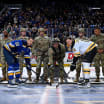4. Low-scoring series
Detroit scored the fewest goals among playoff teams, and Henrik Zetterberg's 50 points were the second-fewest by a team scoring leader; Nazem Kadri led the Toronto Maple Leafs with 45 points.
Injuries to Stamkos, Johnson, and defenseman Anton Stralman will reduce scoring for the Lightning, tightening up what will already be a defensive series.
More importantly, each team is very strong defensively. Detroit allowed 3,174 shot attempts, the second-fewest in the NHL behind the Los Angeles Kings (3,159). Tampa Bay allowed 3,251 shot attempts, which ranked fourth.
5. Offensive-zone start percentage
A team's puck-possession rate is often estimated using its share of all shot attempts, but another method reveals that this will be a series between two of the teams that place the highest priority in controlling the play.
Detroit had an offensive-zone start percentage of 53.7, which was second in the NHL, and Tampa Bay's was 52.2, which was third. That suggests a mutual ability to drive the play into the opposing zone, and keep it there. The Los Angeles Kings led the NHL at 55.9.


















